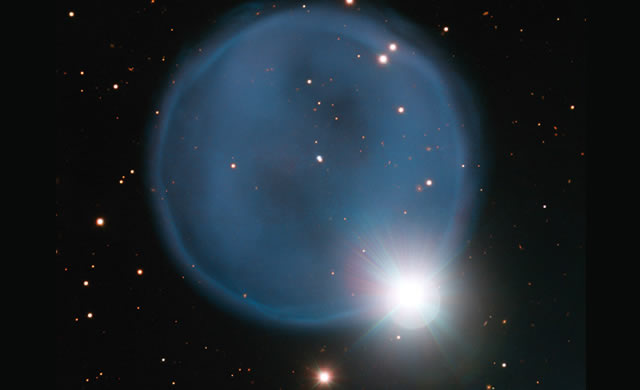
Alcuni astronomi, usando il VLT (Very Large Telescope) dell’ESO in Cile hanno catturato questa appariscente immagine della nebulosa planetaria PN A66 33 – nota comunemente come Abell 33. Creata quando una vecchia stella ha espulso i proprio strati esterni, questa bellissima bolla blu è allineata, per caso, con una stella in primo piano che la rende molto simile a un anello di fidanzamento. La gemma cosmica è insolitamente simmetrica, risultando quasi circolare sul piano del cielo.
La maggior parte delle stelle di massa pari a quella del Sole finiscono la propria vita come nane bianche – piccoli corpi, molto densi e caldi, che lentamente si raffreddano nel corso di miliardi di anni. Nel percorso verso la fase finale della loro vita, le stelle si spogliano delle atmosfere lanciandole nello spazio e creano le nebulose planetarie, nubi di gas rilucente di brillanti colori che circonda il piccolo relitto stellare. Questa immagine, catturata dal VLT (Very Large Telescope) dell’ESO, mostra la nebulosa planetaria Abell 33, incredibilmente tonda, a circa 2500 anni luce dalla Terra. Essere perfettamente circolari non è una proprietà comune in questi oggetti – di solito qualcosa disturba la simmetria e causa le forme irregolari delle nebulose planetarie. La stella particolarmente brillante che si trova al bordo della nebulosa crea una straordinaria illusione in questa immagine del VLT: è solo un allineamento casuale – la stella, HD 83535, si trova in primo piano rispetto alla nebulosa, circa a metà strada tra la Terra e Abell 33, proprio al posto giusto per rendere l’immagine ancora più bella. Insieme, HD 83535 e Abell 33 creano un anello di diamanti scintillante.
Fonte/Leggi tutto → ESO.org
Astronomers using ESO’s Very Large Telescope in Chile have captured this eye-catching image of planetary nebula PN A66 33 — usually known as Abell 33. Created when an aging star blew off its outer layers, this beautiful blue bubble is, by chance, aligned with a foreground star, and bears an uncanny resemblance to a diamond engagement ring. This cosmic gem is unusually symmetric, appearing to be almost circular on the sky.
Most stars with masses similar to that of our Sun will end their lives as white dwarfs — small, very dense, and hot bodies that slowly cool down over billions of years. On the way to this final phase of their lives the stars throw their atmospheres out into the space and create planetary nebulae, colourful glowing clouds of gas surrounding the small, bright stellar relics. This image, captured by ESO’s Very Large Telescope (VLT), shows the remarkably round planetary nebula Abell 33, located roughly 2500 light-years from Earth. Being perfectly round is uncommon for these objects — usually something disturbs the symmetry and causes the planetary nebula to display irregular shapes. The strikingly bright star located along the rim of the nebula creates a beautiful illusion in this VLT image. This is just a chance alignment — the star, named HD 83535, lies in the foreground of the nebula, between Earth and Abell 33, in just the right place to make this view even more beautiful. Together, HD 83535 and Abell 33 create a sparkling diamond ring.
Source/Continue reading → ESO.org





















